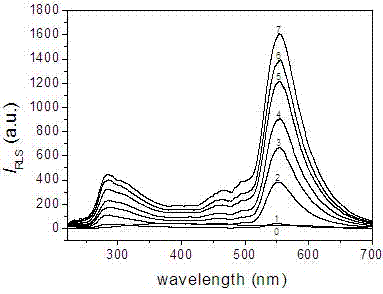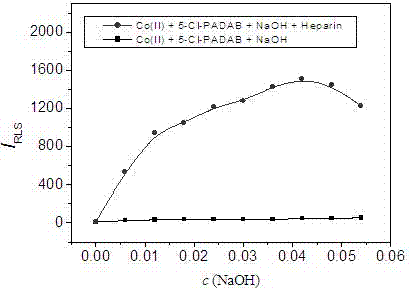Resonance light scattering detection method for sodium heparin
A technology of resonance light scattering and detection method, applied in the field of analysis, can solve the problems of complex molecular structure of heparin sodium and incapability of artificial chemical synthesis, etc., and achieve the effects of short detection time, rich detection methods, and satisfying detection requirements.
- Summary
- Abstract
- Description
- Claims
- Application Information
AI Technical Summary
Problems solved by technology
Method used
Image
Examples
Embodiment Construction
[0024] Hereinafter, the present invention will be described in detail through specific experiments with reference to the accompanying drawings.
[0025] The heparin sodium solid used in the experiment is the product of China Pharmaceutical Group Shanghai Chemical Reagent Company (160 IU / mg), and its solution is prepared with water; the Co(II) solution is CoCl 2 aqueous solution; the cobalt reagent is 4-(5-chloro-2-pyridylazo)-1,3-diaminobenzene, abbreviated as 5-Cl-PADAB, and its solution is prepared with absolute ethanol. The resonance light scattering spectrum and intensity involved in the experiment ( I ) were measured by F-4500 fluorescence spectrophotometer (Hitachi).
[0026] 1. Resonance light scattering spectrum characteristics of the interaction between Co(II), cobalt reagent and sodium heparin
[0027] Add 1.0 mL 2.0×10 to a 10.0 mL test tube sequentially -4 mol / L Co(II) solution, 0.8 mL 5.0×10 -4 mol / L cobalt reagent solution and 1.4 mL 0.3 mol / L NaOH solutio...
PUM
 Login to View More
Login to View More Abstract
Description
Claims
Application Information
 Login to View More
Login to View More - R&D
- Intellectual Property
- Life Sciences
- Materials
- Tech Scout
- Unparalleled Data Quality
- Higher Quality Content
- 60% Fewer Hallucinations
Browse by: Latest US Patents, China's latest patents, Technical Efficacy Thesaurus, Application Domain, Technology Topic, Popular Technical Reports.
© 2025 PatSnap. All rights reserved.Legal|Privacy policy|Modern Slavery Act Transparency Statement|Sitemap|About US| Contact US: help@patsnap.com



